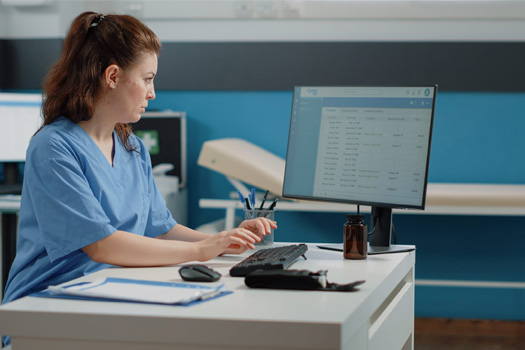How Medical Documentation Is Made Simple with Medical Scribing

With the increasing demand for medical documentation services, medical scribing has become a powerful tool that can help reduce physician burnout and simplify the medical documentation process. In this blog post, we will examine what medical scribing is and how it can help reduce physician burnout. We will also consider how medical documentation is made easier with medical scribing and the future of medical documentation with medical scribing. By the end of this post, you should understand what medical scribing is and how it can help reduce physician burnout and simplify the process of medical documentation.
What Is Medical Scribing?
Medical scribing is a process that involves taking notes and recording observations of a patient’s medical history during a visit with a doctor. Scribes are typically nurses, doctors’ assistants, or other healthcare professionals who have been trained to take accurate and complete notes during visits. This information is then digitally recorded and can be accessed by the doctor or other healthcare professionals involved in the patient’s care.
There are many benefits to medical scribing. For one, it can help to ensure accuracy in medical documentation. When scribes are properly trained, they are able to take detailed notes that accurately reflect all of the information that was discussed during the visit. This helps to ensure that all of the pertinent details are captured and can be used when making decisions about the patient’s care. Additionally, medical scribes provide another set of eyes when it comes to reviewing medical records – something that can help prevent mistakes.
Providing digital access to medical records is also an important benefit of using medical scribing services. This allows patients and their families conveniently access to their health records, without having to travel to see their doctor or spend time filling out paperwork. It also helps keep healthcare data safe and secure by preventing unauthorized individuals from accessing it.
While there are many benefits associated with using medical scribing services, some issues also need attention. One issue is security – especially when it comes to sensitive personal data such as social security numbers or health information concerning minors. Another issue is privacy – particularly when patients share personal details such as intimate photos or health secrets with their scribe. However, with proper training and protocols in place, these issues can be resolved successfully.
How Medical Scribing Helps Reduce Physician Burnout
Medical scribing has become an essential part of the medical profession, and for good reason. With medical scribes on hand, doctors can reduce their workload and help to reduce physician burnout. Medical scribing is a type of technology that assists doctors in documenting and logging patient care. By taking notes as they observe a patient’s symptoms and examination, medical scribes help to improve accuracy and efficiency in the doctor’s office. This can result in reduced costs for patients due to faster treatment times and improved accuracy in medication dosing. Additionally, medical scribes can assist with regulatory compliance by recording patient interactions, including conversations with other physicians or hospital staff members.
For anyone looking for a career that has the potential to save lives, medical scribing is an excellent option. As technology continues to evolve and advance, so too does the role of medical scribing in the doctor’s office. By learning more about this unique career opportunity, you can make sure that you’re making the most of your potential as a medical scribe!
How Medical Scribing helps with Managing Medical Documentation
Medical documentation is a necessary part of healthcare, but it can be a time-consuming and error-prone process. That’s where medical scribing comes in. Medical scribes are skilled professionals who take care of the administrative tasks associated with medical documentation, freeing up physicians and nurses to focus on more important tasks.
The benefits of using medical scribes are numerous and include reduced time in the medical document management process, fewer errors, and increased patient care. By integrating medical scribing into your organization’s overall data management system, you can ensure that all pertinent information is available when it’s needed. In addition to these benefits, successful implementations of a medical scribing system often lead to reductions in costs associated with paperwork and mistakes made during the documentation process.
Now that you know what medical scribing is and what it can do for your organization, it’s time to learn how to implement this system successfully. We’ve provided examples of successful medical scribing implementations in healthcare organizations so that you have a better understanding of what’s possible. Armed with this knowledge, you’ll be able to start putting together a plan for implementing medical scribing in your organization today!
The Future of Medical Documentation with Medical Scribing
Medical scribing is a process that has been around for many years and is still used in many hospitals and clinics around the world. Medical scribing is a form of digital medical documentation, and it is becoming more popular due to its benefits. Here are just some of the reasons why you should consider using Medical Scribing in your office:
Benefits of using Medical Scribing to simplify and streamline medical documentation:
- Improved efficiency in creating and updating patient charts quickly: With Medical Scribing, you can create charts quickly and easily without spending hours filling out paperwork. This saves both time and money, as well as reduces the number of errors that can be made due to human error.
- Enhanced accuracy with fewer errors due to human error: With reliable digital patient files, there are far fewer chances of human error causing inaccurate data. This means that doctors can rely on accurate information when making decisions about patients, which leads to improved communication between them and their patients.
- Reduced paperwork, costs, and time associated with paper documentation: Instead of spending hours filling out endless forms or writing long reports, medical staff can use Medical Scribing to enter information into a digital patient file quickly. This reduces costs associated with paper documentation while freeing up valuable time for more important tasks, such as patient care.
- Increased focus on patient care: By having all relevant data at their fingertips, doctors are able to provide better care for their patients by focusing on specific areas of concern rather than trying to keep track of numerous paper documents.
- Benefits for both medical staff and patients: In addition to reducing the paperwork burden for staff members, using Medical Scribing also benefits patients by making it easier for them to access their medical records and understand what is being done FOR them (rather than being told).
Overall, Medical Scribes are an essential part of any modern hospital or clinic – they save time while improving accuracy and communication between doctor & patient & reducing paperwork hassle!
Conclusion:
Medical scribing is a valuable tool for improving medical documentation accuracy, efficiency, and security. It allows for faster processing times and improved access to important healthcare data. With proper training and protocols in place, medical scribing can help reduce physician burnout while providing patients with better access to their records. Implementing a medical scribing system in your organization can help you improve the quality of healthcare you provide to your patients. If you want to learn more about how medical scribing can benefit your organization, contact us today!
Contact Us
Recent Posts







